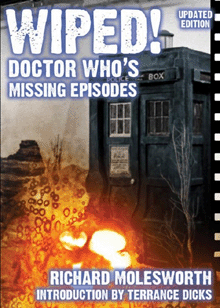As the tally stands, 106 episodes from the 1960’s black and white era no longer reside in the BBC archives. Whole stories starring William Hartnell and Patrick Troughton exist only as off-air recordings and pages of tele-snaps. In addition, some of Jon Pertwee’s episodes have had to be elaborately recolourised to restore them after the original colour master tapes were disposed of.
Long the subject of fan rumour and conjecture, Wiped! Doctor Who’s Missing Episodes sets out to chronicle how this sad state of affairs came to be. It also details the efforts that have taken place since to restore the archive.
At 575 pages, this book is a serious investigation and not a light read. Author Richard Molesworth starts from the basics with the first chapter covering a brief but essential education into the history of television. The second explains the way Doctor Who, and most television dramas of the time, were produced and their relationship with the mediums of film and video tape.
 As the book progresses we are led through the labyrinthine paper trails of the BBC and become intimate with production codes and edit versions. It is soon clear that from an outside perspective very little is straightforward in this tale of woe.
As the book progresses we are led through the labyrinthine paper trails of the BBC and become intimate with production codes and edit versions. It is soon clear that from an outside perspective very little is straightforward in this tale of woe.
As well as the programme’s production there are internal politics to master, like the relationship between the Engineering and Drama departments. On top of that, BBC Enterprises add the dimension of international sales. Each department had different agendas and attitudes to the material, adding further complications to the story
Despite these levels of complexity, Molesworth keeps a direct and engaging tone, as he highlights mysteries and areas of conjecture. He also tackles various fan theories, putting to bed some which have persisted for many years. Differing international television standards, frame and field rates and film technology are all explained in a concise manner.
Thankfully the BBC eventually developed a coherent retention policy and the first Archive Selector Sue Malden makes an important contribution to the book, She halted the routing wiping of programming in the 1970s and, by sheer luck, chose Doctor Who as her pet project to help her understand what had happened, what survived and crucially why this was the case.
As the book proceeds through the years, there are some heart-warming stories of episodes returned to the archives, as well as chronicles of the heroic efforts undertaken by fans to make this happen. All international sales of the programme are comprehensively tracked and the tales of discoveries at boot fairs and the back of cupboards make for compelling reading.
Wiped! is a tremendous achievement, though not for the faint-hearted and is essential fodder for anyone keen to know the facts. Not only does it accomplish the aim of becoming the definitive story of what occurred, but along the way it charts the development of television production on the mediums of both film and video tape.
The book goes beyond the mere fate of episodes too, detailing the work done to track down clips and additional footage over the years. More than this, it provides a fascinating insight into methods of recolourisation, reverse standards conversion and the other amazing lengths the restoration team have gone to in an effort to right this wrong.
This second edition covers the December 2011 return of ‘Galaxy 4: Air Lock’ and ‘The Underwater Menace: Episode Three’ and Molesworth strikes an honest and cautious tone about further discoveries, nonetheless hoping that his lists of missing episodes will need to be rewritten again in the future. He also poses a fascinating question: Would Doctor Who have garnered such a passionate following over the years if all the episodes existed?
![]()
Published on 28 February 2013 by Telos Publishing Ltd.
What did you think of the book? Let us know below…

